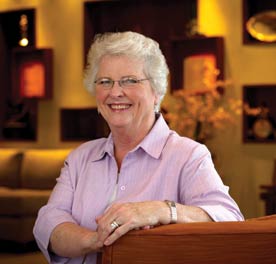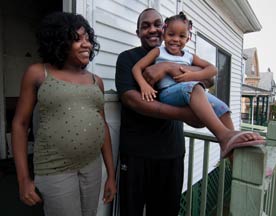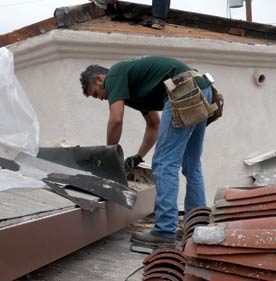Over the past few years the world of impact investing—investing to make money and do good at the same time—has been growing considerably. The Mercy Mortgage Resolution Fund [now Mortgage Resolution Fund, LLC] that you developed is a great practical example of bringing the capital markets into our world, together with the government sector, so that we can do our work at scale, the kind of scale rarely achieved in the nonprofit world. How do you see the role of capital markets in the work that you do changing over the next 5 to 10 years?
I think the MRF, or as we call it, the “Murf” initiative, is really exciting. It grew out of our experience in Chicago managing their NSP funds. That work was targeted in neighborhoods that had experienced foreclosures and had a lot of broken-down or boarded up homes and a lot of vandalism. That work was an after-the-fact response.
We said clearly there’s got to be a better way. How do we come up with something that keeps people in their homes and helps these families avoid the tragedy of foreclosure that people just don’t get over quickly? And so that’s kind of how this whole Mortgage Resolution Fund was born. And the fact that we’ve partnered with three other national nonprofit organizations who are very capable I think gives it additional heft, and I think gets it more attention to do what we want to do.
The idea that these impact investors want to do good and want to make money is nothing new. That’s what the whole premise of the tax credit was. We want to do good. We want to get a return. They got a phenomenal return and made a lot of money on it. That’s good. And we got the housing done. It’s just that there has to be a more efficient system for it. And they provided the equity to the nonprofits that we didn’t have before the Low Income Housing Tax Credit and could never have gotten to the point we are without it.
We’ve been talking about [impact investment] for a while and trying to figure out what we should be measuring in terms of the impact of the housing that would be attractive to these impact investors. The Federal Reserve had put on a conference in Washington, D.C.— probably almost a year ago now—where they brought in impact investors, the major foundations, and some academics. They had a couple of practitioners, and talked about what the impact investors were looking for in terms of how they could actually measure the social impact of their investment easily.
And after listening for a day, I thought to myself, “Wow, they don’t really know what they want to measure.” I was hoping to get a sense of what they wanted to measure so we could go out and put something in place that would do that and be able to attract some of this money, but I don’t think they really knew what they wanted to measure, nor really did the foundations. Measuring social impact is not an easy thing. It’s just not. And the academics and the foundations sometimes don’t appreciate how difficult it is for the practitioners to measure it.
At any rate, we’ve got to come up with a social impact initiative that looks at the financial, the social, and the environmental. We’re pretty well set on the financial indicators, what those would be. We know you can determine the environmental indicators, because there’s a lot of work going on across the country by lots of different groups. It’s the social piece that is the challenge.
We’re still working on that, although we think we’re getting really close. It’s taken us a couple years, so it’s not easy. If we can come up with something that these impact investors like and want to invest in, that could be a huge boost for the nonprofit housing industry. I’m not sure we are there yet. I’d like to be, but I think we still have work to do. And we’ve got to get working on it because, with the cuts in HUD’s budget and what may come down the pike in ’13, the funding for what we do is going to be drastically reduced.
What are your thoughts about the current state of the affordable housing and community development fields, what are the challenges, and how should those challenges be addressed?
The community development world in the last 25, 30 years has really become very sophisticated, particularly the affordable housing side. We’re involved in such a complex world that we have to be good at. And a lot has been done through the intermediaries, LISC, Enterprise, and HAC and a few of those others who support local groups to grow. That’s been a big piece of it.
What the larger nonprofits have done in many instances is recognize, I think, that that local presence is important. The development happens locally. You have to develop those relationships locally. You can’t do some of this from a national platform. And that was part of the huge value of these CDCs. But I think, as we’ve seen over the last 10 or 15 years, there’s been some consolidation in the smaller CDCs. And I don’t think that’s necessarily a bad thing. I think if you could consolidate two or three or however many in order to strengthen the one organization that could attract additional resources, that’s probably the right direction to go. And you could still find ways to maintain a local presence where you need it.
At Mercy, we have a kind of hybrid model. We have a national presence and national strategies, but they’re implemented locally through our regional groups. And I think that, in some ways, combines the best of both and strengthens both the regional groups and the national group, partly because—and again, this goes back to the people who loan to us or invest in us or give us money to do this work—they are telling us they like the idea of the local folks having a national screen, as you would say, so that there’s another set of eyes looking at all of these deals that are coming through.
And that’s important, because there’s a lot of scrutiny upfront on these deals and whether, in fact, they’re going to make it long-term, because we’re not doing anybody any favor by building something and three years later having us going into bankruptcy. That’s not something that makes a lot of sense to me.
So I think our model of a national strategy and a national presence that can attract resources implemented locally has been one of the things that has been a strong point for us.
I think there needs to be more of that. I think there will be more consolidation in the next couple years, depending on how much worse the financial environment gets, because most of these groups, both the small and the large, don’t have a lot of equity that they’re sitting on and that can help them get through the ups and downs of these real estate cycles. Mercy has grown in part through consolidation with other groups where it made sense for us.
_






After reading the entire interveiw of Sister Lillian Murphy; words seem inadequate to express my admiration for her.
Knowing her leadership ability and her geniune caring for those that lack the economic resources to access quality, safe housing opportunties and the ability to assess health care makes me proud to be staff at Mercy Housing.